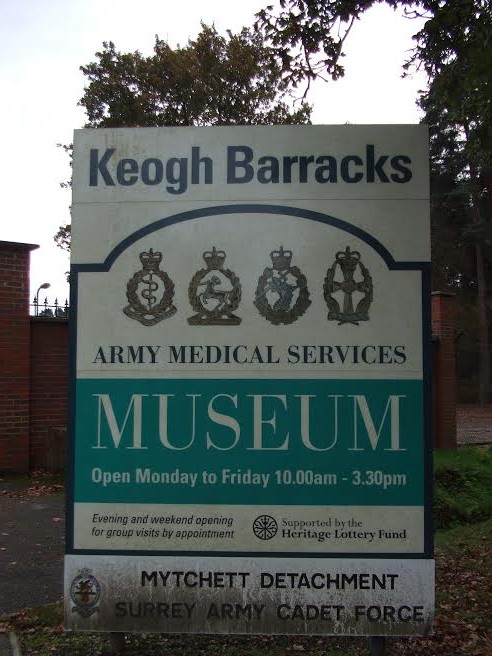As one of the tiny team of grannies who run Words for the Wounded (well, tiny in number, if not in shape – we do like our cakes) I thought it apt to take along a grandchild to explore the ARMY MEDICAL SERVICES MUSEUM set within Keogh Barracks, Ash Vale, Aldershot. GU12 5 RO. It is after all the commemorative year of the start of the 1st World War and very much in many of our minds.  The young are always up for some leeches, a bit of gore, and history brought to life, and this museum very much ticked the box. It is a small museum but beautifully formed and tells the story of the Army’s medical services from the Civil War to present day, not just for humans but their animals as well. Once inside the Museum we were faced with a tableau showing a scene from the civil war and some of the crude instruments used – it really makes you appreciate our modern NHS. As you walk through the well laid out displays we realised how medical practices have had to change to cope with modern warfare. From long impractical uniforms, to fit for purpose ‘ no messing’ togs. No more lethal looking knives, dirty bandages or leeches just well equipped medics and field hospitals. Queen Alexandra’s Royal Army Nursing Corps. (QARANC) When we think of army nurses you probably think of Florence Nightingale going out to the Crimea to superintend the running of Scutari; her work is still remembered today. On display are the uniforms the nurses wore with their starched aprons and cap no ‘scrubs’ for them. Margaret Graham, our WforW founder, was telling me of her mother’s exploits as an army nurse in WW2 after she was posted to India. It was after that war that the Army Medical Services underwent reorganisation. In 1949 the QARANC was formed but the culture remained the same, a selfless sense of duty as they care for the sick and wounded troops worldwide The final displays bring you right up to the present day and the troops serving in Afghanistan.
The young are always up for some leeches, a bit of gore, and history brought to life, and this museum very much ticked the box. It is a small museum but beautifully formed and tells the story of the Army’s medical services from the Civil War to present day, not just for humans but their animals as well. Once inside the Museum we were faced with a tableau showing a scene from the civil war and some of the crude instruments used – it really makes you appreciate our modern NHS. As you walk through the well laid out displays we realised how medical practices have had to change to cope with modern warfare. From long impractical uniforms, to fit for purpose ‘ no messing’ togs. No more lethal looking knives, dirty bandages or leeches just well equipped medics and field hospitals. Queen Alexandra’s Royal Army Nursing Corps. (QARANC) When we think of army nurses you probably think of Florence Nightingale going out to the Crimea to superintend the running of Scutari; her work is still remembered today. On display are the uniforms the nurses wore with their starched aprons and cap no ‘scrubs’ for them. Margaret Graham, our WforW founder, was telling me of her mother’s exploits as an army nurse in WW2 after she was posted to India. It was after that war that the Army Medical Services underwent reorganisation. In 1949 the QARANC was formed but the culture remained the same, a selfless sense of duty as they care for the sick and wounded troops worldwide The final displays bring you right up to the present day and the troops serving in Afghanistan.
Royal Army Veterinary Corp. (RAVC) Due to the growing mechanisation of the army the RAVC is one of the smallest Corps but one which provides an invaluable service for animals in their care. It was sad to discover the terrible treatment injured horses, mules and dogs received especially during the Crimea and Boer Wars. Slowly it was realised a proper veterinary service was needed for these valued animals and by the end of WW1 things were very different. A tableau also shows the heroic work of tracker dogs sniffing out insurgents, explosives and injured personnel. So, today, there are no leeches, but instead high-tech kind efficient care, recuperation and rehabilitation. If you’re in the area of Aldershot, do check the Army Medical Services Museum. www.ams-museum.org.uk/museum/ Rehabilitation and recovery is where Words for the Wounded comes in, along with many other hard working charities, especially as our troops return from Afghanistan and the work of charities such as ours is needed more than ever. www.wordsforthewounded.co.uk WforW raises money through writing prizes, so that, as well as raising money for our wounded service personnel, we create opportunities for aspiring writers. This year we have our usual short competition of up to 400 words of fiction/poetry/memoir with cash prizes for the top three, and publication in Writers’ Forum Magazine. www.writers-forum.com In addition we are launching the Independent Author Book Award for self-published fiction or memoir. The top prize is a professional press release from Palamedes PR www.palamedes.co.uk  And a review in the fabulous Frost Magazine. 2nd and 3rd place have the opportunity of a discounted press release and Frost Magazine will also review their books.
And a review in the fabulous Frost Magazine. 2nd and 3rd place have the opportunity of a discounted press release and Frost Magazine will also review their books.  We open for entries from 11 November 2014 to 11th March 2015 and you can find all the information on www.wordsforthewounded.co.uk and more news and chat on www.wordsforthewounded.blogspot.co.uk
We open for entries from 11 November 2014 to 11th March 2015 and you can find all the information on www.wordsforthewounded.co.uk and more news and chat on www.wordsforthewounded.blogspot.co.uk
